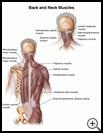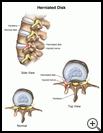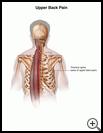
Back Pain
What is back pain?
The spine is made up of a group of bones in your back called vertebrae, which protect the spinal cord. Each vertebra has several bones, muscles, and ligaments to help keep the vertebrae in their proper position. Ligaments are strong bands of tissue that connect one bone to another to form the joints. In between the vertebrae are gel-like shock absorbers called disks. Nerves that lead to the body pass between the layers of vertebrae bones.
Vertebrae are named based on where they are located in the back. Cervical vertebrae are found in the neck, thoracic vertebrae in the upper back, and lumbar vertebrae in the lower back. The sacrum is below the lumbar vertebrae and is made up of 5 fused bones. Below that, your tailbone is made up of 3 fused bones called the coccyx.
Back pain may be caused by:
- Injuries or overuse, which most often affects muscles, joints and ligaments
- Poor posture
- Being overweight
- Poor body mechanics when lifting
- Pressure on spine nerves, due to:
- Disk thinning or rupture causing loss of space between the vertebrae
- Narrowing of the spinal canal by abnormal bone growth or osteoarthritis
- Osteoporosis, which is thinning and weakening of the bones
- Any bone fracture in the vertebrae bones
- Structure problems you were born with, such as scoliosis
- Infection
- Tumors
- Movement of the gel disc from between the vertebrae, or subluxation
What can I expect in the hospital?
You may need to stay in the hospital if you have severe pain not controlled with your current treatment or you need surgery to treat the pain.
Several things may be done while you are in the hospital to monitor, test, and treat your condition. They include:
Monitoring
- You will be checked often by the hospital staff.
- Your heart rate, blood pressure, and temperature will be checked regularly.
- Your strength, range of motion, and ability to feel pain will be checked regularly.
Testing
Testing may include:
- Blood tests to check for infection or certain diseases that may be causing your back pain
- Neurologic exam, which is testing to check your strength, sensation, balance, and reflexes
- Magnetic resonance imaging (MRI): A powerful magnetic field and radio waves are used to take pictures from different angles to show thin cross sections of the spine and spinal cord.
- Computed tomography (CT) scan: A series of X-rays is taken from different angles and arranged by a computer to show thin cross sections of the spine if you are not able to have an MRI.
- X-rays: Pictures of the spine to check for abnormal areas
- Discography: An X-ray is taken after an injection of contrast dye into a disk in your spine to check for the cause of back or neck pain.
- Myelography: A series of X-rays is taken after injecting contrast dye into the fluid around your spinal cord to show the spinal cord, nerves, and blood vessels around the spinal cord.
- Bone scan: A series of detailed pictures is taken after your healthcare provider injects a small amount of radioactive chemical into your blood. The scan shows any areas of bone where the radioactive chemical is being absorbed.
Treatment
The treatment for back pain depends on the cause, your symptoms, how well you respond to treatment, your overall health, and any complications you may have.
Your chance of cure depends on the cause of your back pain and the treatments available. You may need to make lifestyle changes to get and stay healthy, manage your treatments, or adjust to any activity limits that you may have.
- You will have a small tube (IV catheter) inserted into a vein in your hand or arm. This will allow for medicine to be given directly into your blood and to give you fluids, if needed.
- You may need an injection of medicine in the area around your spine to reduce swelling and back pain.
- You may need one or more of these surgeries to treat back pain. Surgeries include:
- Facetectomy: Surgery to remove spine joints to reduce pressure on nerves
- Foraminotomy: Surgery to widen the opening where the nerve leaves the vertebra
- Laminectomy: Surgery to remove a part of vertebrae that may be pressing on the spinal cord
- Laminotomy: Surgery to widen the opening of the bones that surround and protect the spinal cord
- Spinal fusion: Surgery to stabilize the bones in the spine with a piece of bone or ceramic, which is held in place with plates, screws, or rods. Spinal fusion may be done with:
- Discectomy: Surgery to remove all or part of a disk, which may be pressing on a nerve
- Corpectomy: Surgery to remove an entire vertebra that may be squeezing the disk. Your surgeon may replace this disk with an artificial disk.
- Kyphoplasty or vertebroplasty: Surgery where biologic cement is injected into collapsed vertebrae to prop it up and relief pressure on the nerves
- Your provider may prescribe medicine to:
- Treat pain
- Treat or prevent an infection
- Reduce swelling
- Treat or prevent side effects, such as nausea or constipation, from other treatments
- Your provider may recommend other types of therapy to help relieve pain, other symptoms, or side effects of treatment.
- You may need physical or occupational therapy to help you adjust to chronic (long-term) back pain, strengthen the muscles in your back, or recover from back surgery. Most rehabilitation programs include:
- Physical therapy to help you regain muscle strength and teach you ways to move safely
- Occupational therapy to help you learn safe ways to do the tasks that you previously did
- If your nerves are damaged and you have trouble with your bowel or bladder, therapy may include skin, bladder, and bowel care and training.
What can I do to help?
- You will need to tell your healthcare team if you have new or worsening:
- Back pain
- Depression
- Lightheadedness
- Loss of balance or coordination
- Change or loss of bladder or bowel control
- Numbness in your legs, feet, arms, or hands
- Redness, swelling, pain, warmth, or drainage from your surgical wound
- Fever, chills, or muscle aches
- Swelling of your legs, ankles, or feet
- Trouble with muscle movements, such as moving arms and legs
- Ask questions about any medicine, treatment, or information that you do not understand.
How long will I be in the hospital?
How long you stay in the hospital depends on many things, such as your general health, why you are in the hospital, and the treatment you need. Talk with your provider about how long your stay may be.
Last modified: 2016-10-13
Last reviewed: 2015-12-21




